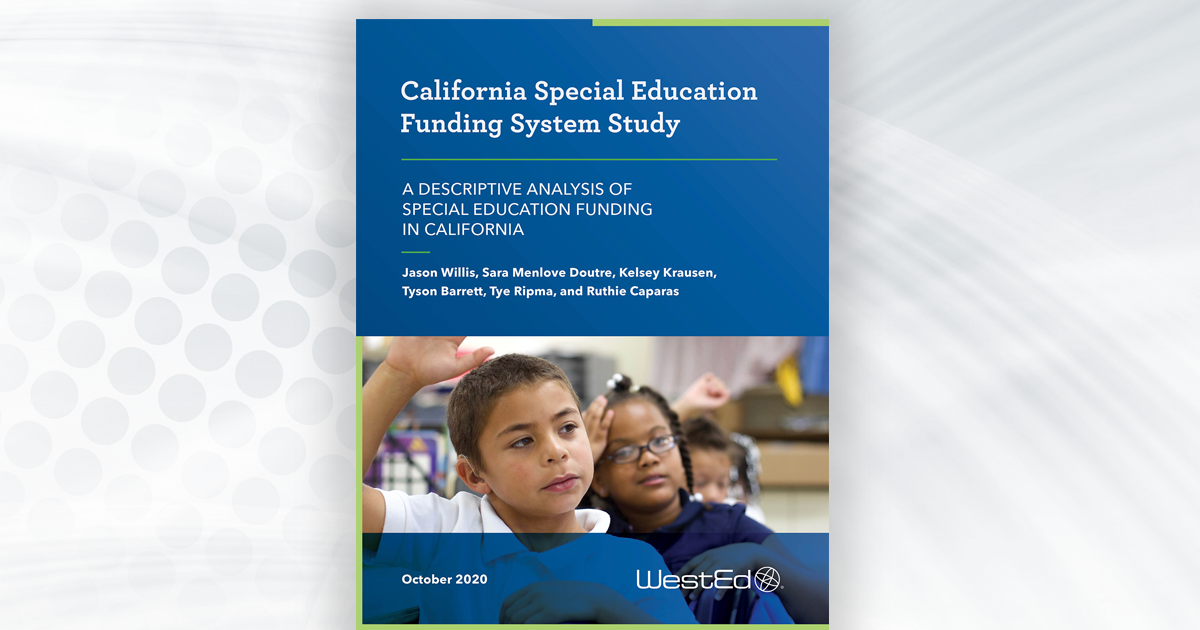WestEd Special Education Study: Inclusive Funding Needed to Promote Inclusive Practices
Posted on by Jason Willis, Sara Menlove Doutre

WestEd is pleased to announce the publication of a new California Special Education Funding System Study that identifies the opportunity for increased coordination between general and special education funding and better differentiation based on student needs.
More than 725,000, almost 12 percent, of California’s public school students receive special education and related services. More than half of those students spend 80 percent or more of the school day in a general education classroom and, at the end of each school year, these students take the same assessments as their peers without disabilities and their results are tallied as part of the state’s accountability system. The system for funding special education in California may not be as inclusive as California classrooms, however.
In 2013, the state of California dissolved most of its separate funding streams for public education into its Local Control Funding Formula (LCFF) and while special education is included in the accountability mechanisms associated with LCFF, special education funding remains separate. The new WestEd study provides a history and detailed description of state special education funding, setting the foundation for refinement of the current system through exploration of other funding systems and examination of California’s special education population and funding structures.
Jason Willis, Area Director of Resource Planning and Strategic Implementation at WestEd and co-director of the study, says the goal of an education funding system is to provide the right amount of funding to the right agencies so that they can provide the right services to the right students.
“Naturally, each of these actions is easier said than done but nonetheless a necessary goal to ensure the most effective use of public education dollars,” he says.
School districts and charter schools are required to provide special education services to each student with a disability through an individualized educational program, or IEP, and California’s education system spends more than $11 billion dollars to fund those services each year. The WestEd study focuses not on how much money is needed for special education, but on how current levels of funding can be used most effectively, including through better coordination and by differentiating special education funding to match the wide variety in student need and cost of implementing IEPs for students with disabilities. Current special education funding is based on a per child rate and provides supplemental funds for only the costliest programs, not fully accounting for the potential differences in cost to implement IEPs for students with different needs.
In a similar study of Maryland’s special education funding system, Willis and co-director Sara Doutre found that students with disabilities in states with funding formulas that provided different levels of funding for different types of special education students performed better on academic assessments. Doutre, Senior Program Associate for Special Education Policy and Practice at WestEd, pushes back against a common concern that differentiated funding systems incentivize practitioners to place more students in special education and in more severe disability categories.
“The amount of state funding to be gained by a district who inappropriately identifies a student as having a disability, currently about $6500 per special education student, does not even cover the typical cost of evaluating that student to determine whether they have a disability. Districts and schools will not risk an unnecessary legal commitment to ongoing special education services for that small amount of money.”
WestEd will follow this descriptive report with a report on potential options to refine the system, supported by research, and the potential benefits and drawbacks of each option. Recommendations will be presented in the context of the current economic and fiscal realities of California brought on by the COVID-19 pandemic and will include considerations for changes that do and do not require additional investments in funding and changes that can be implemented over different periods of time.
